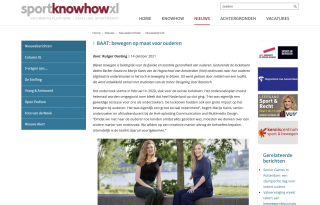Digital life in the media with active toolkit
21-10-2021

Dr Marije Kanis and Berber Nauta gave an interview for SportKnowhow XL about the creative 'one week in the life of' toolkit for the elderly. This was developed and evaluated together with students of the Designing User Research and Care Technology minor. During the lockdowns, they used this to conduct remote research into how to (digitally) support the elderly in their well-being and still keep it moving.
Dr. Marije Kanis, together with Berber Nauta, gave an interview for SportKnowhow XL about the creative 'one week in the life of' toolkit for the elderly. This was developed and evaluated together with students of the Designing User Research and Care Technology minor. During the lockdowns, they used this to conduct remote research into how to (digitally) support the elderly in their well-being and still keep it moving.
Interview
BAAT: tailor-made exercise for the elderly
by: Rutger Oosting | October 14, 2021
Keeping moving is important for the physical and mental health of the elderly. During the lockdowns, Berber Nauta and Marije Kanis of the Amsterdam University of Applied Sciences (HvA) conducted research into how to (digitally) support the elderly in keeping active. This was done by means of a toolkit, which was developed together with students of the Designing User Research minor.
The research started in February of 2020, just before the first lockdown. The research plan had to be completely overhauled when it turned out that the whole of the Netherlands was going into lockdown. “It was actually a great test case for us as researchers. The lockdown also had a major impact on exercise among the elderly. It was actually a major social experiment,” begins Marije Kanis, senior researcher and graduate lecturer at the AUAS Communication and Multimedia Design programme. 'Because we couldn't go to the elderly because everything was closed, we had to think about a different way of research. We wanted to determine the needs in a creative way. Ultimately, the toolkit evolved from that.'
Toolkit
The idea of the research stems from the fact that elderly people often fall into a gap in terms of exercise, for example when a treatment with a remedial therapist stops after eight sessions. 'The idea was first to create a supportive app so that the elderly can look together with a therapist at what they like and what options are available,' says Berber Nauta, lecturer-researcher at the AUAS Remedial Therapy programme. 'That can vary a lot. From a running group in the neighbourhoods, to finding a buddy to play tennis with. That was the original idea. Due to the corona virus, this was no longer possible. We then devised the toolkit in collaboration with students from the Designing User Research minor.'
The toolkit consists of a number of daily questions, a folder with exercise tips, QR codes to online instructional videos about fitness and a fitness elastic band. With this, Nauta and Kanis hoped to activate the elderly (online) and inspire them to exercise. 'The diary was filled in for a week by fifteen participants,' adds Nauta. 'Each day the participants had to indicate how they felt with a number, what they were going to do that day and what was most important. At the end of the day, they had to rate the day and indicate which things went well and which could be improved. In addition, the elderly were given a (short) assignment every day.'
By completing the diary, it became clear to the elderly how much and how they still move and do each day. 'In one assignment, the elderly had to indicate by means of a drawing where they felt strong and where they felt weak. It was striking that the elderly also related this to their mental well-being. Many participants indicated that they are happy that everything is still in order in their heads. We actually did not know that many elderly people are so concerned with this.'
Activate
The booklet made the elderly more aware of how much one actually moves. 'There was a lady who indicated that she didn't move much,” says Nauta. “Then the booklet and the activity cards stated that she does take her babysitters to school every day and pick them up again by bicycle. That is also movement. And there was a couple who sometimes went salsa dancing in the kitchen after dinner. I thought that was great stuff to read.'
The booklet also mentioned online tools that encourage people to exercise (more). From apps to photos of exercises. 'For example, we noticed that the elderly increasingly began to exercise in front of the television,” says Kanis. “Because of the tips from the booklet, some elderly people suddenly started looking for exercises on YouTube, for example with the fitness elastic.” The tips are presented with a QR code. Could the elderly cope with this? “What was nice to see was that some people had difficulty with it at first, but that the QR code is now very popular because of the Corona check app. So this has been a great exercise.'
Healthcare professionals
The research has not only provided insight into the activation of exercise among the elderly. 'The toolkit has also been evaluated among healthcare professionals. These were very enthusiastic. Many professionals only see one client for half an hour a week. The diary and activity cards could be used to start a conversation with the elderly.” Nauta also says: “Through the booklet we were able to get to know the elderly and their world well. They also found the toolkit a good way to gain additional insights about exercise. They were remarkably open about their physical and mental well-being. They also really liked the fitness band and wanted to continue using it.'

